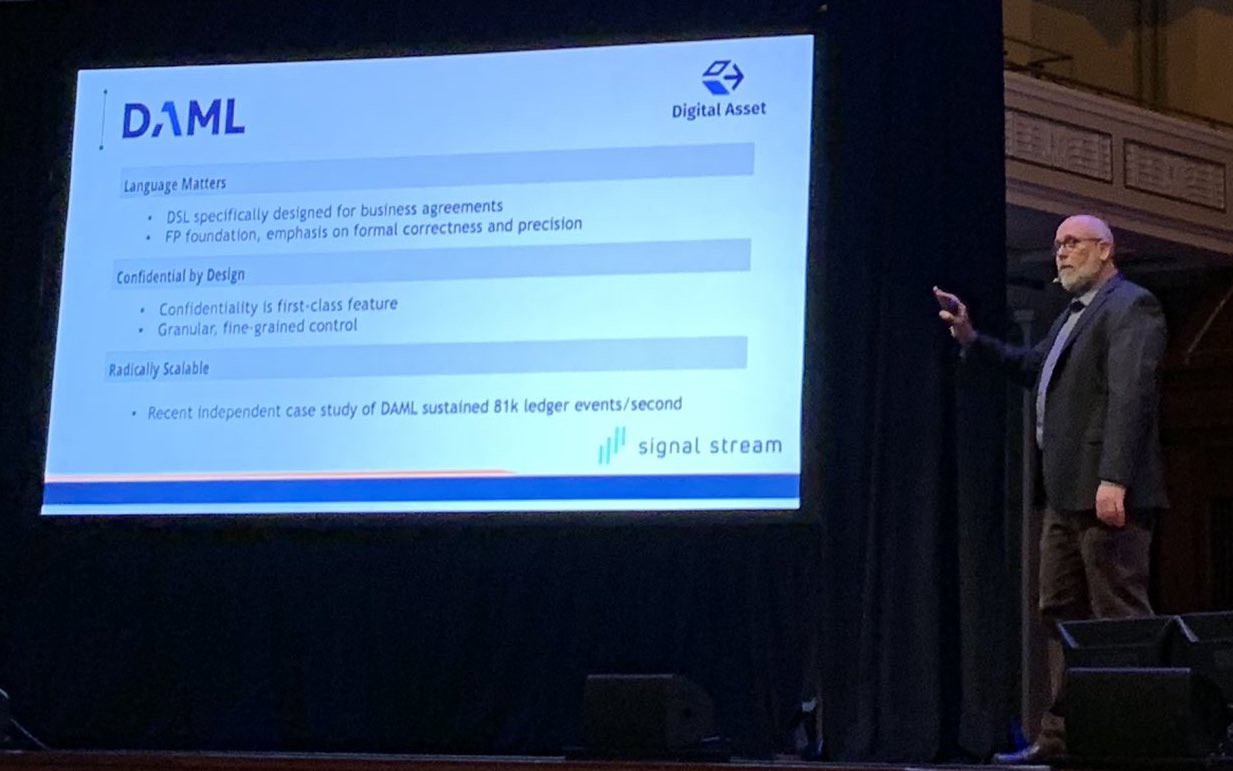Guest post by Corey Todaro, Chief Product Officer, Hashed Health

How do seasoned veterans at one of the world’s top provider of blockchain technology healthcare solutions rate Daml — Digital Asset’s smart contract modeling language for distributed ledger technology (DLT) — for solving core healthcare business problems? In this third of a series of guest blog posts by our partners, customers, and others working with the Daml SDK, Hashed Health’s Corey Todaro discusses how Daml is helping them bring their Signal Stream product to market.
Since 2016, Hashed Health has worked to introduce blockchain and distributed ledger technologies (“DLT”) to healthcare. Founded by and comprised of healthcare industry veterans, Hashed Health engages with enterprises from all corners of this diverse industry, ideating and building innovative distributed solutions to address healthcare’s long-standing issues. Hashed Health believes in the disruptive potential for DLT but knows that change within a highly regulated and complex industry like healthcare is challenging. Hashed Health rises to that challenge with thoughtful and strategic design. Our obsession is DLT use case design, balancing varied constraints and regulatory realities to produce DLT frameworks and platforms that meet the needs of diverse stakeholders — easing inefficiency and generating measurable business value for our clients.
Our design process has always been agnostic as to DLT platform selection. We’ve designed multiple prototypes on a variety of blockchain and DLT platforms in an effort to assess their ease of use for both developers and end-users. We’ve mapped a wide range of DLT options to problem classes commonly faced by our enterprise healthcare clients. The metaphor of a toolbox is apt — blockchain and DLT platforms comprise a toolbox which contains a variety of tools useful for addressing and tackling specific problems.
For every business or administrative challenge, there is a right tool to provide a solution. By early 2017, our design process had identified a missing but essential tool. As we worked to reimagine and redesign various business processes in healthcare, confidentiality and privacy were — and remain — essential requirements in any design. While nearly all enterprise-grade DLT platforms provide features for transactional confidentiality, these features at best resulted in over-complicated designs and at worse failed to meet the stringent privacy requirements of the industry. Put simply, we didn’t have the right tool for the problems before us.
In the spring of 2018, Hashed Health participated in the developer preview program for the Daml SDK and the Digital Asset Platform. The result was more than the simple addition of another platform to our design kit. Rather, Daml — Digital Asset’s modeling language for developing smart contracts — has become an indispensable tool, already serving as the foundation for our healthcare contracting platform, Signal Stream.
In our experience, Daml combines a set of features that make it not only distinct from other DLT platforms but also make it an ideal platform for innovative designs for the healthcare industry. It gives us the ability to do something we’ve not been able to do before with distributed ledger technology.
Language Matters
At the heart of the platform is Daml itself, a domain-specific modeling language used to create transactional templates that define counterparty and related third-party behavior. The majority of enterprise-focused DLT platforms offer the ability to create application logic that can operate on the ledger (so-called Smart Contracts). Developers usually employ a general-purpose programming language to develop these smart contracts. By contrast, Daml is specifically designed to model business and commercial agreements. The concepts of business are core structures of the language itself.
Built on a functional programming foundation, Daml can feel a little restrictive at first, limiting the approaches a developer can take to define a transaction. Indeed, our developers initially found it off-putting. However, within a few short days, we understood that these seeming limitations actually deliver great advantages. Daml is designed for formal correctness. In other words, contracts and transactions written in Daml operate precisely as expected — essential for business trust and value. On other DLT platforms, we need to decide how to best approximate a business interaction and constantly test to assure that the approximation behaves as required because, when you use a general-purpose language, the behavior of that contract can vary. The same input can potentially give a range of unexpected and undesirable outputs — the contract can behave in strange ways. With Daml there is no need to approximate. This led to more efficient use of our development resources.
Language matters; how you write the smart contract and what language you use to write the smart contract matters for the business performance of that contract.
Confidential by Design
One of the more difficult design problems with DLT is transparency of the ledger. Many DLT platforms bear a resemblance, or even a direct relationship, to the original cryptocurrency blockchain platforms. These early platforms were designed for radical transparency. This transparency is essential to both their operation in open, permissionless environments and their trustless, tamper-resistant nature. For enterprises, this transparency at best complicates and at worst limits the benefits of DLT. DLT platforms such as Hyperledger Fabric and Quorum (as well as other Ethereum derivatives) have introduced confidentiality features like private channels, private data collections, and hidden contracts, while still operating on transparent, yet permissioned, ledger networks. While important, these platform developments are secondary designs, often at odds with the original design intention of the platform itself. As a designer, I find these confidentiality schemes to be inelegant after-thoughts.
By contrast, Daml is confidential by design — transactional confidentiality in Daml is a first-class, first-order feature; it is not a secondary add-on. Transactions are only visible to direct counterparties and/or third parties who have been explicitly granted rights to view. Prior to Daml, Hashed Health’s design work was constrained to either ‘data sharing’ use cases in which privacy is not essential or to overly-complicated transactional data models which attempt to preserve privacy on an otherwise open ledger. Daml’s focus on privacy — an essential regulatory business requirement in the healthcare industry — has given us a powerful tool to extend our design and DLT product development. And because of Daml’s fine-grained control over what can be shared with other parties, we can bring in observers, auditors, regulators, third-party service providers — and control precisely what they see out of the transaction. Even if it’s a single piece of data.
Radically Scalable
In 2014, as the financial services and other industry began to consider DLT technology, the scale limitations of open and even permissioned DLT platforms quickly became apparent. Supporting scales of only a few dozen to at most a few thousand transactions per second, many DLT platforms are incapable of supporting the throughput requirements of enterprise workflows.
In healthcare, the needs don’t often approach those of financial markets. In fact, the old saying is that in healthcare, any process taking less than 30 days is ‘real-time’. But as DLT solution designs move from proof-of-concept to production, the problem of scalability is becoming acute. In 2018, Hashed Health has begun work on a number of solutions which require scales beyond the abilities of many DLT platforms. In the DA Platform and Daml, we have found a reliable DLT platform that can accommodate transactional scales achieving 27,000 financial trades per second (which translates to 81,000 ledger updates per second) — the highest I’ve seen. This radical scalability has allowed us to begin designs to address the core payment infrastructure in healthcare — including fee-for-service claims processing, risk-based payment contracts, and other health plan and pharmaceutical financial workflows.
Our new Daml driven product: Signal Stream
Building on our experience with Daml, Hashed Health has recently announced a new healthcare contracting platform, Signal Stream. Built atop the DA Platform and Daml, Signal Stream enables clients to automate multi-party agreements and create an outcomes-based contract adjudication and management platform. This shared performance view is real-time and synchronized through a distributed ledger contractual engine. Addressable areas of healthcare include value- or risk-based contracts, procurement contracting, pharmaceutical rebates and outcomes-based payments and health plan administration. The platform works to:
- Reduce administrative burden related to value-based contract automation;
- Delineate value creation within agreements;
- Offer real-time tracking of contract performance;
- Achieve counterparty consensus regarding performance against contract value metrics and benchmarks.
Daml represents an essential innovative platform design, enabling enterprises to harness DLT within the business frameworks and realities of enterprises today. Hashed Health is excited to partner with DA to realize the promise of DLT for the healthcare industry.
Join the community and download the Daml SDK at daml.com
This story was originally published 11 December 2018 on Medium
About the author
Corey Todaro, Chief Product Officer, Hashed Health
Corey Todaro is CPO of Hashed Health. Hashed Health is a healthcare innovation firm focused on accelerating the meaningful development of blockchain and distributed ledger technologies. Corey is at the forefront of blockchain and distributed ledger designs for the healthcare industry. He brings to Hashed Health experience in venture capital investing in the health IT space as well as a wealth of operational experience in large national health systems with a focus on the challenges of healthcare payment innovation.
Keep in touch with Corey: Email, Twitter, LinkedIn
About Hashed Health
Hashed Health delivers to payers, providers, and suppliers real technical blockchain product solutions focused on decreasing the cost of care and reducing the administrative inefficiencies. We offer strategic services to accelerate blockchain adoption and product development across the healthcare industry by providing subject matter expertise and strategic advisory services to innovative organizations looking to create new networks and redefine business models leveraging blockchain/distributed ledger technology.
 by Corey Todaro
December 11, 2018
by Corey Todaro
December 11, 2018
 by Corey Todaro
December 11, 2018
by Corey Todaro
December 11, 2018
 by Corey Todaro
December 11, 2018
by Corey Todaro
December 11, 2018